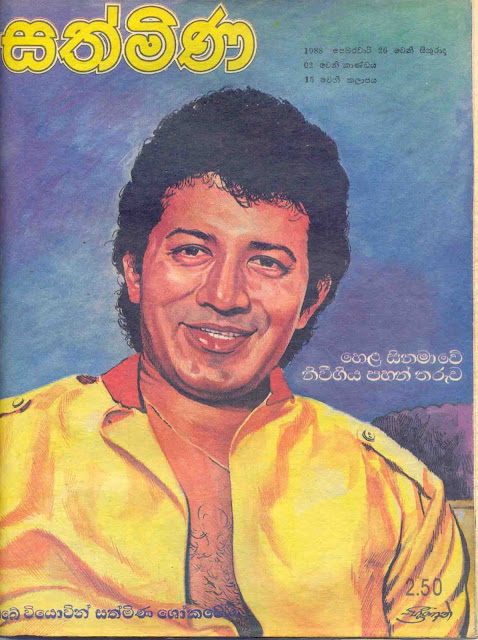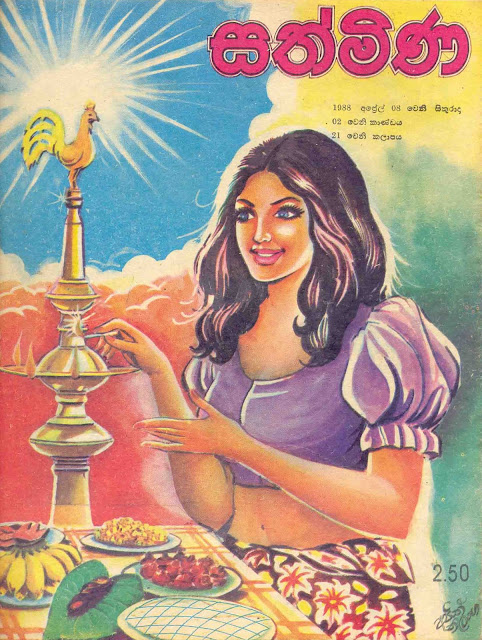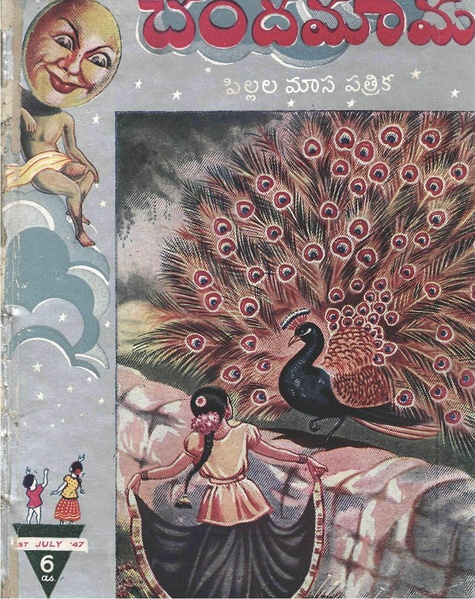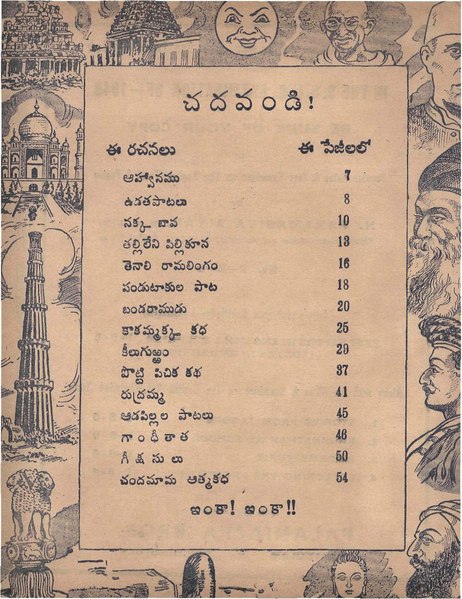Ambili Mama ( Uncle Moon) is a children's magazine that I have been looking for a long time. Recently I found 12 of them. I had soft copies of English, Sanskrit and Telugu but could not find any Sinhala translations. I wasn't even born when It started. It started in India in 1947 and was published recently. It was translated into Sinhala in June 1978. I don't know how long it was published in Sinhala.
Many people remember the story of Vethal. About five years ago, I was asked to translate the Vetal stories into a book, but I stopped because of laziness. Special thanks go to Saman Kumara Pitiwila Liyanage who found and gave these magazines.
Chandamama was a classic Indian monthly magazine for children, famous for its illustrations. It also published long-running mythological/magical stories that ran for years. Originally, "Chandamama" was started in Telugu by B.Nagi Reddy and Chakrapani, noted Telugu Filmmakers. It was edited by Kodavatiganti Kutumba Rao, a very close friend of Chakrapani and a literary colossus in Telugu Literature, who edited it for 28 years, till his death in August 1980.
The main features of Indian Mythology were written entirely by Kutumbarao, who also developed the magazine by encouraging young writers in Telugu and adapting them to suit the Telugu written style that he made so popular in Andhra and the Telugu-speaking people for decades. Some of the stories and the folklore features were written by Dasari Subrahmanyam, who made serials like Patala Durgam, etc., very popular.
Chandamama was published in 13 languages (including English), and had a readership of about 200,000.
Telugu
Tamil (as Ambulimama)
Kannada
Sanskrit
Assamese
Hindi
Odia (as Jahnamaamu)
English
Marathi (as Chandoba)
Malayalam (as Ambili Ammavan)
Bengali (as Chadmama)
History
The first edition of Chandamama was released in July, 1947. The founder editor of the magazine was Chakrapani. It was printed and published by B.Nagi Reddy who later became a leading film producer in South India. Chakrapani, a friend of Nagi Reddy, was the force behind magazine, and his vision, perception and understanding of the target readership brought name and fame to the magazine.
Chandamama was first published in Telugu and Tamil (as Ambulimama) in July 1947. Kannada edition first appeared in July 1949 followed by Hindi in August 1949. Marathi (as Chandoba) and Malayalam (as Ambili Ammavan) editions appeared in April 1952 followed by Gujarati in 1954, English in 1955, Odia (as Jahnamamu)[3] and Sindhi in 1956, Bengali (as Chadmama) in August 1972, Punjabi in 1975, Assamese in 1976, Sinhala in 1978, Sanskrit in April 1984 and Santali in 2004. The Punjabi, Sindhi and Sinhala editions were published only for a short period. No English editions were published from October 1957 to June 1970. The magazine ceased publication in 1998, owing to labour disputes. However, the magazine relaunched a year later. It was available in 12 Indian languages and English.
For many decades, Chandamama's illustrators defined the look of the magazine. They included such names as M.T.V. Acharya, T. Veera Raghavan, who signed his work as Chithra; Vaddadi Papaiah, who signed as Vapa; Kesava Rao who signed as Kesava; M. Gokhale; and K. C. Sivasankaran, alias Sankar, who joined Chandamama in the year 1951, and continues to draw even in 2011, in an unbroken association of 6 decades, not associated with chandamama. Later artists such as Shakthi Dass; M. K. Basha, who signed as Razi; Gandhi Ayya, aka Gandhi; and P. Mahesh (Mahe), also continued the tradition into current times.[4] Initially, the covers were printed in four colours, while the illustrations inside used line drawings. Each page of Chandamama had an illustration, although, in the strict sense of the term, Chandamama is not a comic book, with the exception of the Chitra-katha column.
to download a sinhala copy
to read english and other language copies
අම්බිලි මාමා කාලයක් තිස්සේ හොයපු සඟරාවක්. ළඟදි ඉන් පිටපත් 12ක් ම හම්බවුණා. මෙහි ඉංග්රීසි, සංස්කෘත, තෙළිඟු මෘදු පිටපත් තිබ්බත් සිංහල සඟරාවක් සොයාගන්න බැරිව හිටියේ. මෙය ආරම්භ කරන කොට මම ඉපදිලත් නැහැ. ඉන්දියාවෙ 1947දි ආරම්භ වෙලා මෑතක් වෙන තුරු ප්රකාශයට පත් වුණා. සිංහලට පරිවර්තනය වුණේ 1978 ජූනිවල ඉඳන්. කොපමණ කාලයක් සිංහලෙන් නිකුත් වුණා ද කියලා දන්නෙ නැහැ.
මා එක්ක කතා කරපු හුඟක් අයට මතක මෙහි පළ වූ වේතාල කතා. වසර පහකට විතර කලින් එම වේතාල කතා පොතක් ලෙස පරිවර්තනය කරන්න කියලා ගත්තත් කම්මැළිකමට නතර කළා. මෙම සඟරා ටික සොයා දුන්නු Saman Kumara Pitiwila Liyanage අයියට කොහොම ස්තුති කරන්න ද මන්දා....
මේ එම සඟරාව ගැන අන්තර්ජාලයේ දක්වා ඇති අදහස්...
චන්දමාමා යනු ළමයින් සඳහා වූ ඉන්දියානු මාසික සඟරාවක් වූ අතර, එය වසර ගණනාවක් පුරා දිවෙන දිගුකාලීන මිථ්යා / ඉන්ද්රජාලික කථා ද ප්රකාශයට පත් කළේය. මුලින්, "චන්දමාමා" තෙළිඟු භාෂාවෙන් ආරම්භ කරන ලද්දේ ප්රසිද්ධ තෙළිඟු චිත්රපට නිෂ්පාදකයින් වන B.Nagi Reddy සහ Chakrapani විසිනි . එය සංස්කරණය කරන ලද්දේ චක්රපානිගේ ඉතා කිට්ටු මිතුරෙකු සහ තෙළිඟු සාහිත්යයේ සාහිත්ය දැවැන්තයෙකු වන කොඩවටිගන්ටි කුටුම්බා රාඕ විසිනි, ඔහු 1980 අගෝස්තු මාසයේදී මිය යන තෙක් වසර 28 ක් එය සංස්කරණය කළේය.
ඉන්දියානු මිථ්යා කථාවල ප්රධාන අංග සම්පුර්ණයෙන්ම ලියා ඇත්තේ කුටුම්බරාඕ විසින් වන අතර, ඔහු තෙළිඟු භාෂාවෙන් තරුණ ලේඛකයින් දිරිමත් කරමින් සඟරාව සංවර්ධනය කර තෙළිඟු ලිඛිත ශෛලියට ගැළපෙන පරිදි අනුවර්තනය කළේය. සමහර කතා සහ ජනප්රවාද විශේෂාංග ලියා ඇත්තේ දසරි සුබ්රමනියම් විසිනි, ඇය ලියූ පාතාල දුර්ගම් වැනි කතා මාලා ද ඉතා ජනප්රිය විය.
චන්දමාමා භාෂා 13 කින් (ඉංග්රීසි ඇතුළුව) ප්රකාශයට පත් කරන ලද අතර 200,000 ක පමණ පාඨක පිරිසක් සිටියහ.
තෙළිඟු
දෙමළ ( අම්බුලිමාමා ලෙස )
කන්නඩ
සංස්කෘත
ඇසෑමි
හින්දි
ඔඩියා ( ජහ්නමාමු ලෙස )
ඉංග්රීසි
මරාති ( චන්දෝබා ලෙස )
මලයාලම් ( අම්බිලි අම්මාවන් ලෙස )
බෙංගාලි ( චද්මාමා ලෙස )
සිංහල ( අම්බිලි මාමා ලෙස)
ඉතිහාසය -
1947 ජූලි මාසයේදී චන්දමාමා ප්රථම මුද්රණය නිකුත් විය. සඟරාවේ ආරම්භක කර්තෘ වූයේ චක්රපානි ය. එය මුද්රණය කර ප්රකාශයට පත් කරන ලද්දේ පසුව දකුණු ඉන්දියාවේ ප්රමුඛ පෙළේ චිත්රපට නිෂ්පාදකයෙකු බවට පත් වූ B.Nagi Reddy විසිනි. නාගි රෙඩ්ඩිගේ මිතුරෙකු වූ චක්රපානි සඟරාව පිටුපස සිටි බලවේගය වූ අතර, ඔහුගේ දැක්ම, ඉලක්ක පාඨක ප්රජාව පිළිබඳ අවබෝධය සහ අවබෝධය සඟරාවට නමක් සහ කීර්තියක් ගෙන දුන්නේ ය.
චන්දමාමා ප්රථම වරට තෙළිඟු සහ දෙමළ භාෂාවෙන් (අම්බුලිමාමා ලෙස) 1947 ජූලි මාසයේදී ප්රකාශයට පත් කරන ලදී. කන්නඩ සංස්කරණය ප්රථම වරට 1949 ජූලි මාසයේ දී ද පසුව හින්දි 1949 අගෝස්තු මාසයේ දී ද පළ විය. මරාති (චන්ඩෝබා ලෙස) සහ මලයාලම් (අම්බිලි අම්මාවන් ලෙස) සංස්කරණ 1952 අප්රේල් මාසයේ දී පළ වූ අතර ඉන් පසුව ගුජරාටි 1954 දී ඉංග්රීසි, 1955 දී ඔඩියා (ජහ්නමමු ලෙස) [3] සහ 1956 දී සින්ධි , 1972 අගෝස්තු මාසයේ බෙංගාලි (චද්මාමා ලෙස), 1975 දී පන්ජාබි , 1976 දී ඇසෑමි , 1978 දී ඇසෑමි , 1978 දී සංස්කෘත , 1984 අප්රේල් සහ සන්තාලි2004 දී පන්ජාබි, සින්ධි සහ සිංහල සංස්කරණ කෙටි කාලයකට පමණක් ප්රකාශයට පත් විය. 1957 ඔක්තෝම්බර් සිට 1970 ජූනි දක්වා ඉංග්රීසි සංස්කරණ කිසිවක් ප්රකාශයට පත් කළේ නැත. කම්කරු ආරවුල් හේතුවෙන් 1998 දී සඟරාව ප්රකාශනය නතර විය. කෙසේ වෙතත්, සඟරාව වසරකට පසුව නැවත ආරම්භ විය. එය ඉන්දියානු භාෂා 12කින් සහ ඉංග්රීසියෙන් ලබාගත හැකි විය.
දශක ගණනාවක් තිස්සේ චන්දමාමාහි චිත්ර ශිල්පීන් සඟරාවේ පෙනුම නිර්වචනය කළහ. චිත්රා ලෙස ඔහුගේ කෘතියට අත්සන් කළ එම්ටීවී ආචාරියා, ටී. වීර රාඝවන් වැනි නම් ඒවාට ඇතුළත් විය. වපා ලෙස අත්සන් කළ වඩ්ඩාදි පාපයියා , කේසව ලෙස අත්සන් කළ කේසව රාඕ; එම්. ගෝඛලේ; සහ 1951 වසරේ චන්දමාමයට සම්බන්ධ වූ කේ.සී සිවසංකරන් හෙවත් සංකර්, දශක 6ක් තිස්සේ චිත්ර ඇන්දෝ ය. ශක්ති දාස් වැනි පසුකාලීන කලාකරුවන් ; රාසි ලෙස අත්සන් කළ එම්.කේ.බාෂා; ගාන්ධි අය්යා, නොහොත් ගාන්ධි; සහ P. මහේෂ් (මහේ) ද අතීත සම්ප්රදාය වත්මන් කාලය දක්වාම පවත්වාගෙන ගියේය. මුලදී, ආවරණ වර්ණ හතරකින් මුද්රණය කරන ලද අතර, ඇතුළත රූප සටහන් රේඛා ඇඳීම් භාවිත කරන ලදී. චිත්ර කතා තීරුව හැරුණු විට චන්චදමාමා යනු කොමික්ස් ( චිත්රකතා) පොතක් නොවුණත්, වචනයේ පරිසමාප්ත අර්ථයෙන්ම චන්දමාමා හි සෑම පිටුවකම නිදර්ශන චිත්රයක් විය.























